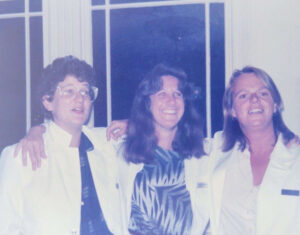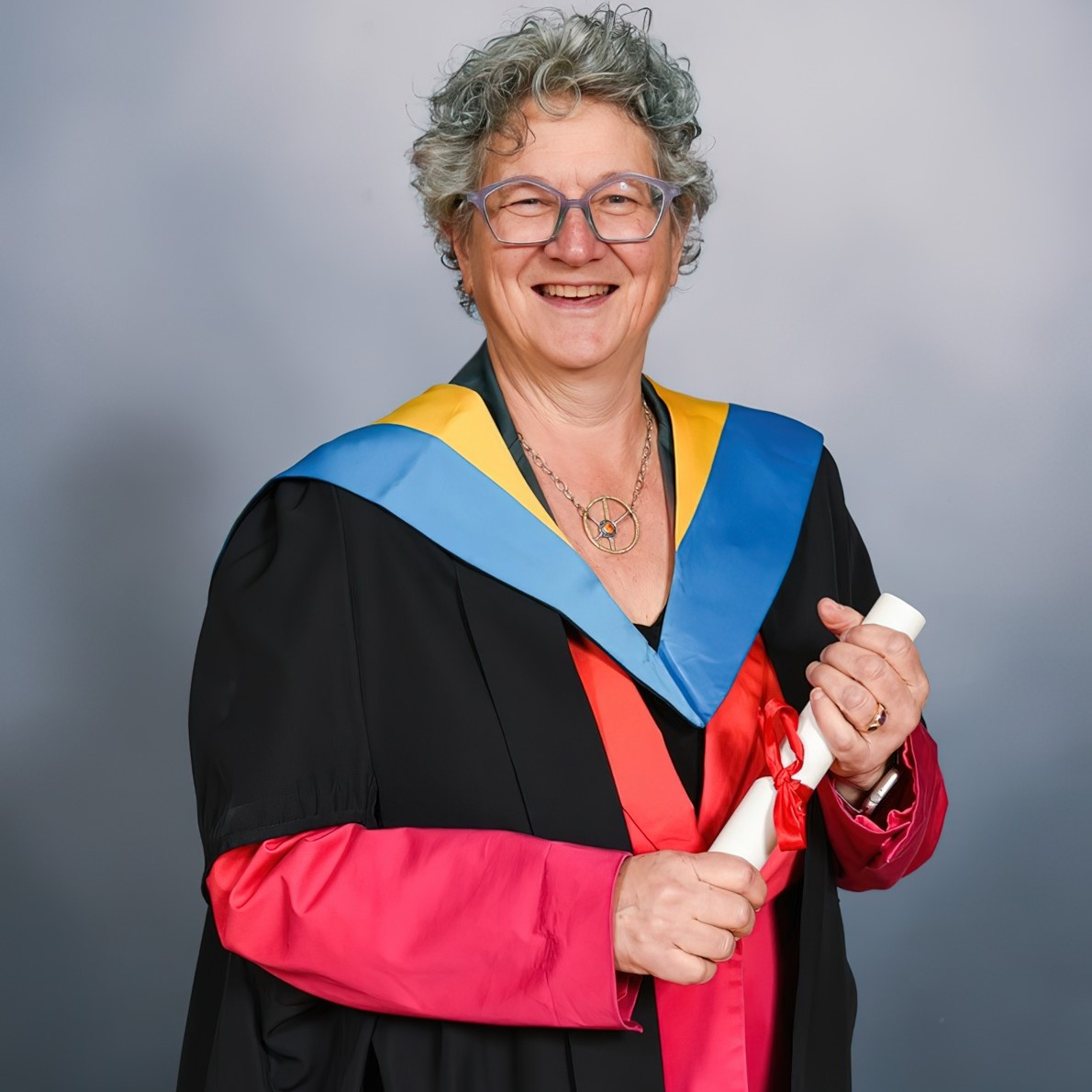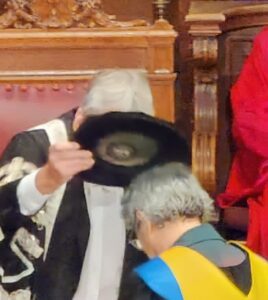Reflecting on aging is like turning the kaleidoscope a notch, where each turn reveals a different pattern.
At the beginning of the pandemic, I decided to return to school at the age of 61 for a Master’s Degree in Public Health.
In 2020 I was worried that if the COVID-19 pandemic got worse, I wouldn’t be able to see my patients in person. As a chiropractor in San Francisco, I wanted to be able to continue providing care in person and be helpful during this or any future pandemics, similar to how I had been during the HIV pandemic. I also wanted to contribute to improving the public health messaging that was being shared.

L to R – Barbara, Dr. Carol Spiegelman DC, Dr. Patricia Simon, DC – 1983 – 1st day of student clinic
But returning to school had its own unexpected challenges. No computers were used in education in 1982 when I began attending Palmer Chiropractic College. When I started practicing in 1987, I would physically go to the UCSF campus library once a month with a list of ailments my patients had, and I would research the conditions and treatments in medical journals. I enjoyed these outings, until I got my first computer in 1995. It was a large desktop, considered blazingly fast at 1 GB! The neighbors literally came over to ask it questions, and we joked that the desktop would soon be the new hearth of the home.
Fast forward 30 years.
I mustered up my courage and curiosity and enrolled in the online Master’s in Public Health program at the University of Edinburgh. Three years later and 40 years after my first college class, I graduated with a wealth of knowledge, way beyond public health.
It had been humbling to go from a feeling of professional competence to “a beginner’s mind” when I became a student again in my 60s. I have learned so much about collaboration, a special gift for someone who usually works alone in private practice. I have improved my writing skills, computer skills, and patience. I’ve learned new ways to think about problems and new ideas for solving them from the bottom up.
In year one, my first revelation was that online school did not come to me –– I had to go and find it. It was my first gentle introduction to public health. My next big lesson was needing to up my social media skills: If not for the What’s App chat, I would have failed immediately because I did not understand how to find the discussions nor how to read the assignment. As a cohort, we had Zoom groups to determine what transpired and the assignment’s actual question.
Without this resource, I would not have been able to continue. We broke down the assignments to help us understand what the professor wished us to accomplish. Postings on the discussion board complemented this, but even knowing what questions to ask came from the What’s App group.
This was the experience that felt closest to on-campus student life. It felt like going to a coffee shop to discuss our coursework after class. Much of online school felt lonely –– trapped at home on a computer, endlessly reading and writing.
A unique issue from being an aging student –– I had a vitreous detachment of my eye. I found the constant screen time painful in one eye, but I dismissed it as eye strain until small black streams floated into my visual field. Luckily, this was not a surgical emergency, just a reminder to train myself to take more visual breaks to reduce the associated eye fatigue. This was the first of many challenges of dynamic aging — to acknowledge the issue, decide to adapt and move forward. And not give up!

Graduation from University of Edinburgh with family – L to R – Nigel Berkeley, Barbara and wife Wendy Storch
There were no physical books in my recent incarnation of student life, only endless online readings. There were no coffee dates, gatherings in the quad to discuss anything or practice sessions. Online discussions were more in the form of a posted discussion board and had rules of engagement that were quite formal. This is a British university, after all. This cultural difference continued in many ways, as the British university engaged anonymous readers to grade your papers, leaving no opportunity for discussion or engagement with the grader.
The cultural tone of all discussion groups was one of modest self-deprecation, and I worried that my very American enthusiasm and friendliness would strike the wrong tone.
I also found I was not only at a computer more but also in odd postures, like in bed with a laptop on a pillow. This led to hip pain, and I required a shift to modify my study posture. I alternated from floor cushions to a standing set-up to a saddle chair. Taking my own advice was excellent medicine.
The University of Edinburgh has been teaching public health since 1875, and it began its global online program in 2015. The Edinburgh program has a global perspective and emphasizes the intersections of social justice, environmental concerns, and public health education. It is designed for full-time working professionals.
I especially loved the international collaboration with doctors, pharmacists, nurses, occupational therapists, physical therapists –– and even a coffee roaster, concerned about his farmers’ health. My colleagues are in Africa, Asia, the UK, the EU, and the Americas.
As a fantastic, final bonus of this program, the graduation ceremonies were in person in Edinburgh. The ceremony was full of pageantry, with bagpipers, choruses, and an ancient hat that they ‘doffed‘ us with, dating from the university’s founding in 1583. The ritual made me feel included in a community of knowledge.
Gratefully, at least for now in 2024, I can continue to see patients in person, which has been my passion and avocation my entire career. As I reflect on my hard-earned path to a Master’s in Public Health, I have decided to use my degree as an opportunity to share some of my newfound, constantly updated knowledge with others.
Shockingly, I have discovered that many of my patients do not read the medical journal articles I forward. So as part of my graduation requirement, I went on TikTok with a short series of helpful videos to deliver a shorter, pre-digested format.
In turning the kaleidoscope another turn, integrating my newfound knowledge from my Public Health degree into my daily life is the next challenge. I am happy to see that I can still stretch my brain, learn new skills, and to find that the advice I give to my patients is also helpful to me!
Dr. Barbara Berkeley is a chiropractor based in San Francisco, specializing in movement, alignment, and posture. She uses a variety of techniques, including Active Release Technique, abdominal massage, fascial manipulation, and trigger point therapy, to help clients manage pain and improve mobility. She also works with patients to address chronic pain, digestive issues, and anxiety, particularly in younger people. Dr. Berkeley is also a certified personal trainer with CrossFit Level 1, MovNat, and Nutritious Movement certifications, guiding clients in improving strength, flexibility, and overall movement patterns. You can find her at Dr. Barbara Berkeley's website.



Hi Barbara! So nice to hear your story. Congratulations on this recent accomplishment/experience. Wishing you well, Catherine Stifter
What challenges did the author face when returning to school, and how did the introduction of computers change their research process?
Visit us IT Telkom